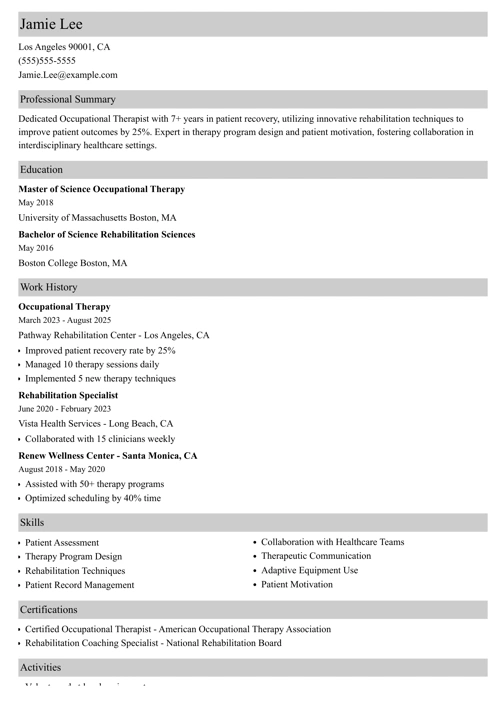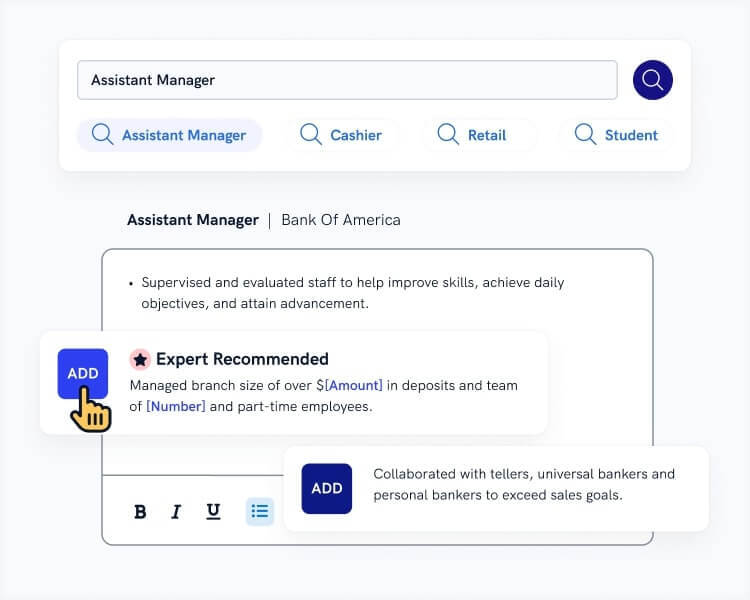If you're an aspiring occupational therapist, your resume is your chance to showcase the healing magic you bring into people's lives. Crafting a standout occupational therapy resume is crucial to landing your dream job. In this article, you'll find expert tips and inspiring occupational therapy resume examples to help you present your skills and experience in the best possible light. Let’s make a job-winning occupational therapist resume!
This guide will show you:
- An occupational therapist resume example that’s better than 9 out of 10 other resumes.
- How to write an occupational therapy resume that will land you more interviews.
- Tips and examples of how to put skills and achievements on an occupational therapist resume.
- How to describe your experience on a resume for an occupational therapist to get any job you want.
Want to save time and have your resume ready in 5 minutes? Try our resume builder. It’s fast and easy to use. Plus, you’ll get ready-made content to add with one click. See 20+ resume templates and create your resume here.
Sample resume made with our builder—See more resume examples here.
One of our users, Brittanya, had this to say:
Zety really helped me create the best resume possible. It pointed out how things could be better on my existing resume and suggested many things to be re-worded or removed.
Want to check more samples related to occupational therapy? Here you go:
- Caregiver Resume
- CNA Resume
- Health Coach Resume
- Nursing Student Resume
- Personal Trainer Resume
- Physical Therapy Resume
- EMT/Paramedic Resume
- Phlebotomy Resume
- Medical School Resume
- The Best Resume Examples for All Jobs
Occupational Therapy Resume Example
Jamie Lee, OTR/L
Occupational Therapist
(555) 234-5678
jamie.lee@email.com
linkedin.com/in/jamie-lee
Summary
Dedicated and compassionate Occupational Therapist with 7+ years of experience helping patients regain independence and improve quality of life. Skilled in assessing patient needs, developing personalized treatment plans, and delivering evidence-based therapy for various conditions. Passionate about empowering individuals and eager to bring expertise in rehabilitation and patient-centered care to Star Rehabilitation Center.
Experience
Occupational Therapist
Sunrise Rehabilitation Center, New York, NY
July 2019–November 2024
Key Qualifications & Responsibilities
- Conduct assessments to determine patients' functional abilities and create individualized treatment plans for optimal rehabilitation.
- Work closely with interdisciplinary teams to coordinate care for patients recovering from strokes, injuries, and surgeries.
- Educate patients and their families on exercises and adaptive techniques to support at-home care and improve everyday functioning.
- Document patient progress and adjust therapeutic interventions to meet changing needs and goals.
Key Achievement:
- Spearheaded a falls prevention program, resulting in a 15% reduction in fall incidents among at-risk patients.
Occupational Therapist
Bright Futures Pediatric Therapy, Brooklyn, NY
August 2017–July 2019
Key Qualifications & Responsibilities
- Provided therapeutic interventions to children with developmental delays, autism spectrum disorders, and sensory processing challenges.
- Developed engaging, play-based therapy sessions to enhance fine motor skills, sensory integration, and social interactions.
- Collaborated with parents and teachers to support children’s progress and create individualized support plans in home and school settings.
Key Achievement:
- Recognized for achieving high parent satisfaction scores due to personalized care and open communication.
Education
Master of Science in Occupational Therapy
New York University, New York, NY
September 2015–May 2017
Bachelor of Science in Psychology
University of California, Los Angeles (UCLA), Los Angeles, CA
September 2011–May 2015
Certifications and Licenses
- Licensed Occupational Therapist (OTR/L), State of New York, License No. OT123456
- Certified in Sensory Integration Therapy, 2018
- Basic Life Support (BLS) Certification, American Heart Association, current
Skills
- Patient Assessment & Treatment Planning
- Rehabilitation Techniques
- Fine and Gross Motor Skills Development
- Patient and Family Education
- Adaptive Equipment Training
- Documentation & Progress Tracking
- Team Collaboration
- Patient Advocacy
Professional Memberships
- Member of the American Occupational Therapy Association (AOTA) since 2017
Languages
- English—Native
- Spanish—Intermediate
Here’s how to write your own occupational therapist resume:
1. Format Your Occupational Therapy Resume Correctly
Your occupational therapy resume must stand out in a sea of applications. A well-organized resume format can make a significant impact on hiring managers and boost your chances of getting noticed.
To format your resume for occupational therapy positions:
- Begin with a resume header that includes your name, phone number, email, and LinkedIn profile. These are crucial contact details for a resume.
- You may omit your full street address but do include your city if it matches the company's location.
- Opt for a reverse-chronological resume, which lists your most recent job first. This is the preferred layout for resumes among hiring professionals.
- Choose a clean, professional font like Calibri or Arial. The ideal font size for resumes is between 10 and 12 points.
- Save your resume file as “Your Name - Occupational Therapist - Resume.pdf.” A PDF format is preferable as it preserves your formatting.
- The recommended resume length for entry-level occupational therapists is one page. If you have extensive experience, consider using a two-page resume or more.
Read more: Resume Templates for Word
2. Customize Your Occupational Therapist Job Description
Tailoring your resume to each job is crucial because generic work experience sections don't make the cut. Hiring managers want to see more than just a list of duties; they need to understand your impact and effectiveness.
Here’s how to add relevant experience to your resume:
- Use the exact job title as advertised. ATS-friendly resumes perform best with precise job titles.
- Following the company name and your employment dates, include 3–6 bullet points. Focus more on recent roles and less on older ones.
- Demonstrate your use of relevant skills by highlighting achievements. The most effective resume accomplishments are quantifiable.
- Begin each bullet point with strong resume action verbs like implemented, evaluated, and orchestrated.
Sample Occupational Therapist Responsibilities for a Resume
- Assess patients' needs and develop customized treatment plans to enhance their daily living skills.
- Collaborate with healthcare professionals to ensure comprehensive patient care.
- Implement therapeutic activities and exercises tailored to each patient's abilities and goals.
- Educate patients and their families on treatment plans and progress.
- Document patient progress and modify treatment plans as needed.
- Maintain compliance with healthcare regulations and ethical standards.
- Conduct assessments to determine patients' home and work environments' suitability for therapy interventions.
Remember to use action verbs that convey your responsibilities and achievements effectively. Here are some action verbs for an occupational therapist:
Occupational Therapist Resume Examples: Action Verbs
- Developed
- Assessed
- Implemented
- Facilitated
- Coordinated
- Educated
- Modified
- Collaborated
- Documented
- Evaluated
Read more: Strong Synonyms to Enhance Your Resume
3. Make Your Education Section Count
While most resumes feature an education section, stopping at just listing your degree and institution can be a missed opportunity. To stand out, leverage your educational achievements to highlight additional skills and accomplishments, boosting your appeal to potential employers.
Consider these resume tips:
- Position your degree information right after your work history for maximum impact.
- For entry-level candidates, include relevant coursework to demonstrate your expertise.
- Even with professional experience, mentioning fellowships, scholarships, or leadership roles can enhance your resume.
- Wondering if you should include your GPA? Do so only if it’s high.
Read more: Listing Your Major and Minor on a Resume
Creating a resume with our builder is incredibly simple. Follow our step-by-step guide and use content from Certified Professional Resume Writers to have a resume ready in minutes.
When you’re done, Zety’s resume builder will score your resume and our resume checker will tell you exactly how to make it better.
4. Prove the Occupational Therapist Skills the Company Wants
Including the right skills on a resume is essential, but it’s all about precision. Rather than randomly listing skills, target those that match the job description to ensure your application stands out.
Here's how to integrate occupational therapist skills into your resume:
- Extract resume keywords from the job listing and incorporate them into your skills section.
- Keep your skills list focused; don't overwhelm the recruiter with too many entries.
- Enhance your chances by weaving these skills into your job and education bullet points.
Remember that highlighting skills that reflect the core values of occupational therapy, as outlined by the American Occupational Therapy Association (AOTA), can enhance your resume's relevance.
Skills such as patient-centered care, therapeutic adaptability, and an understanding of the Occupational Therapy Practice Framework (OTPF) are especially valuable for showcasing your dedication to the field's standards.
Explore some hard skills for a resume along with soft skills:
Sample Occupational Therapy Resume Skills
- Patient Assessment
- Treatment Planning
- Therapeutic Techniques
- Rehabilitation Strategies
- Patient Education
- Progress Documentation
- Healthcare Compliance
- Home Environment Assessments
- Interpersonal Skills
- Verbal and Written Communication
- Team Collaboration
- Problem-Solving Skills
- Time Management
- Attention to Detail
- Adaptability Skills
Read more: Analytical Skills for Any Resume
5. Add Other Sections to Your OT Resume
To truly stand out, consider enhancing your resume with additional sections demonstrating your dedication and expertise. These can offer a deeper insight into your professional persona and commitment to the field.
Here are a few sections that can elevate your resume:
- Highlight any relevant certifications you’ve acquired, such as a Certified Hand Therapist or Neuro-Developmental Treatment certification.
- If you’ve authored articles in professional journals, include them under publications on your resume to establish authority in your field.
- Memberships in professional organizations, such as the American Occupational Therapy Association, can illustrate your engagement and dedication.
- Volunteer work related to occupational therapy can be valuable. Learn where to put volunteer work on a resume to emphasize relevant skills.
- If you speak additional languages, listing them can be advantageous. Discover how to add language skills to your resume to highlight this asset.
Read more: What Makes You Unique as a Candidate
6. Write an Occupational Therapy Resume Summary or Resume Objective
Capturing a hiring manager's attention quickly is crucial. Given that they often spend just a few seconds scanning resumes, starting with a compelling resume introduction can make all the difference.
Consider crafting a resume profile that succinctly encapsulates your professional essence. Often likened to an elevator pitch, this introduction is a brief yet impactful paragraph at the top of your resume. If you have a year or more of experience, highlight your job title, your value to the company, and noteworthy achievements in a resume professional summary.
If you're crafting a resume with limited experience, leverage your academic achievements or personal projects in a resume objective. This approach is especially useful for newcomers eager to showcase their potential.
Read more: Best Ways to Start Your Resume
7. Write a Cover Letter for Your Occupational Therapy Resume
Writing a cover letter is more important than ever in today's job market. Many applicants tend to send out generic resumes, but a personalized cover letter can set you apart and show genuine interest in the position. It's a testament to your commitment to the specific company and role. Plus, 83% of hiring managers view cover letters as important.
To craft an effective cover letter, follow these steps:
- Utilize a professional cover letter structure, ensuring it mirrors the header of your resume and includes a polished closing.
- Follow the proper format for a cover letter, keeping it concise with 3–5 paragraphs, and aim for less than a full page.
- Start by capturing attention with the job title and an engaging opening line.
- Use the middle section to highlight major achievements from your resume.
- Conclude with a strong cover letter closing that introduces a few additional skills and expresses your eagerness to discuss how you can contribute to the company.
- Don't forget to send a follow-up email weekly for a month, keeping it brief and attaching your resume and cover letter PDFs.
Read more: How to Write a Job-Winning Cover Letter?
Plus, a great cover letter that matches your resume will give you an advantage over other candidates. You can write it in our cover letter builder here. Here's what it may look like:
See more cover letter templates and start writing.
About Zety’s Editorial Process
This article has been reviewed by our editorial team to make sure it follows Zety's editorial guidelines. We’re committed to sharing our expertise and giving you trustworthy career advice tailored to your needs. High-quality content is what brings over 40 million readers to our site every year. But we don't stop there. Our team conducts original research to understand the job market better, and we pride ourselves on being quoted by top universities and prime media outlets from around the world.
![Occupational Therapy Resume Examples & Tips [2025]](https://cdn-images.zety.com/pages/occupational-therapy-resume-example-ztus-cta-02.webp)



